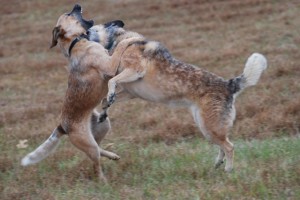While dog aggression can be motivated towards strange dogs or known dogs, the focus of this article will be strange dogs. Many cases of aggression towards a known dog (like with a canine housemate) fall into categories like redirected aggression or dominance aggression. Aggression towards strange dogs that typically manifests itself in barking, growling, lunging, and pulling when seeing other dogs is in a different class.

Inter-dog Aggression vs. Fear
I often receive calls from potential clients concerned that their dog is aggressive on walks or when he sees another dog. And it’s true that the activity normally looks pretty aggressive with the barking, growling, squealing, pulling, and lunging that the dog does on his walks. It looks so bad, in fact, that most clients are avoiding contact with other dogs entirely or have even given up the daily walk altogether.
What most dog owners don’t realize is that in the vast majority of these aggressive dog cases, the motivation behind the aggression is mostly fear on some level. Remember that displays of aggression are not meant to bring something closer to a dog; they are meant to put distance in between the dog and what he is aggressing towards. Additionally, the dog has learned over time that the displays generally keep the other dog away from him and keep it moving (even if that is because the other owner avoids walking his dog near yours!).
When a dog feels the need to bark or growl, he feels threatened on some level. It doesn’t matter if it is rational or not. The most common reason a dog feels threatened is because he is lacking in the ability to properly communicate with another dog. It is likely he hasn’t been exposed positively enough to other types of dogs while growing up, so as he ages and encounters these dogs, he doesn’t know how to handle it. Dogs that have had traumatic experiences with other dogs (like being attacked) also can have intense reactions.
While some level of fear or anxiety is at the root of most cases of dog aggression, it should be noted that there are some dogs that just don’t like other dogs. This is most commonly seen as the dog ages into adulthood. This is a puppy that was playful (or at least tolerant) and such, but as he reached social maturity (2-3 years of age) became less tolerant or simply no longer had an interest in other dogs bothering him. This is most common in breeds of dogs that have a fighting background or are noted to not always be friendly with other dogs. For example, akitas are an old Japanese fighting dog breed that isn’t always tolerant of other dogs, and rottweilers are often not tolerant of boisterous dogs that bounce on them. Not all dogs are Labrador retrievers!
Recovery
Once a dog already has issues with seeing other dogs, it will take some time to reverse these feelings. Attempting to make the strange dog a good thing in your dog’s eyes is always the best way to initially go. Punishment often reinforces for the dog why he was threatened in the first place!
Instead, pairing up the sight of a dog with something positive for your dog is a powerful way to change how he feels about another dog. It is also important to keep the dog within his comfort levels, so that means if seeing a dog 15 feet away is okay for him and 10 feet isn’t, you work on pairing up the reward with the sight of the dog up until the point he would have a hard time, just prior to 10 feet, and then take him out of the situation by making a turn. This not only makes the sight of a new dog better, but it also shows him that his handler takes him out of the situation before he can’t handle it. It develops trust.
Gradually over weeks, you simply reduce the amount of space between the dogs. Many dogs retain a level of personal space of 2-3 feet that they wish to maintain. Other dogs can gradually be introduced to calm dogs. Calm is a must as any dog that reacts back will cause a problem.
While this training process isn’t necessarily difficult, it might be if you are not accustomed to working with these issues. It is recommendable to hire a professional to work with you one-on-one if the dog has a severe case of aggression. An expert can help in the training process to make your dog less reactive to the sight of new dogs.
